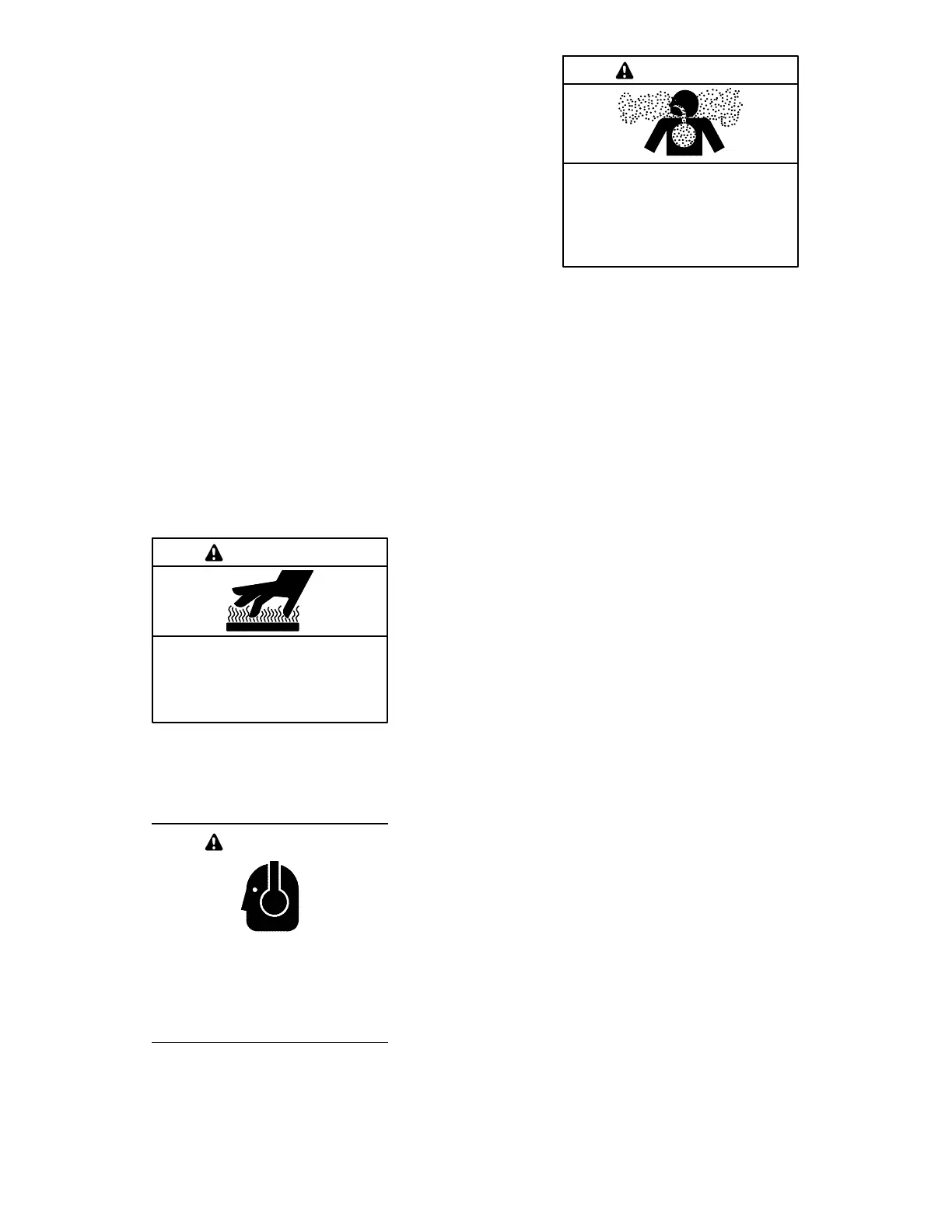TP-6805 8/15 27Section 2 Scheduled Maintenance
6. Do not wash the paper element or use pressurized
air, as this will damage the element. Replace a
dirty, bent, or damaged element. Handle new
elements carefully; do not use if the sealing
surfaces are bent or damaged.
7. When servicing the air cleaner, check the air
cleaner base. Make sure it is secured and not bent
or damaged. Also, check the element cover for
damage or improper fit. Replace all damaged air
cleaner components.
Note: If any loose dirt or debris fell on the air cleaner
base when the element was removed, carefully
remove it and wipe the base clean. Be careful that
none of it drops into the intake throat.
8. Reinstall the paper element onto the air cleaner
base. Make sure the element is flat and properly
seated.
9. Install the air cleaner cover and secure with the two
retaining knobs.
2.6 Air Intake and Exhaust System
Hot engine and exhaust system.
Can cause severe injury or death.
Do not work on the generator set until
it cools.
WARNING
Servicing the exhaust system. Hot parts can cause
severe injury or death. Do not touch hot engine parts. The
engine and exhaust system components become extremely
hot during operation.
Hazardous noise.
Can cause hearing loss.
Never operate the generator set
without a muffler or with a faulty
exhaust system.
CAUTION
Carbon monoxide.
Can cause severe nausea,
fainting, or death.
The exhaust system must be
leakproof and routinely inspected.
WARNING
Generator set operation. Carbon monoxide can cause
severe nausea, fainting, or death. Carbon monoxide is an
odorless, colorless, tasteless, nonirritating gas that can cause
death if inhaled for even a short time. Avoid breathing exhaust
fumes when working on or near the generator set. Never
operate the generator set inside a building unless the exhaust
gas is piped safely outside. Never operate the generator set
where exhaust gas could accumulate and seep back inside a
potentially occupied building.
Carbon monoxide detectors. Carbon monoxide can
cause severe nausea, fainting, or death. Install carbon
monoxide detectors on each level of any building adjacent to
the generator set. Locate the detectors to adequately warn the
building’s occupants of the presence of carbon monoxide.
Keep the detectors operational at all times. Periodically test
and replace the carbon monoxide detectors according to the
manufacturer’s instructions.
Carbon monoxide symptoms. Carbon monoxide can
cause severe nausea, fainting, or death. Carbon monoxide
is a poisonous gas present in exhaust gases. Carbon
monoxide is an odorless, colorless, tasteless, nonirritating gas
that can cause death if inhaled for even a short time. Carbon
monoxide poisoning symptoms include but are not limited to
the following:
D Light-headedness, dizziness
D Physical fatigue, weakness in
joints and muscles
D Sleepiness, mental fatigue,
inability to concentrate
or speak clearly, blurred vision
D Stomachache, vomiting, nausea
If experiencing any of these symptoms and carbon monoxide
poisoning is possible, seek fresh air immediately and remain
active. Do not sit, lie down, or fall asleep. Alert others to the
possibility of carbon monoxide poisoning. Seek medical
attention if the condition of affected persons does not improve
within minutes of breathing fresh air.
The engine fan draws cooling air through the openings
in the sides and end near the battery. The alternator fan
draws cooling air through openings on the side walls of
the enclosure. The cooling air mixes with the engine
exhaust and is discharged at the exhaust outlet. See
Figure 2-11 or Figure 2-12. To prevent generator set

